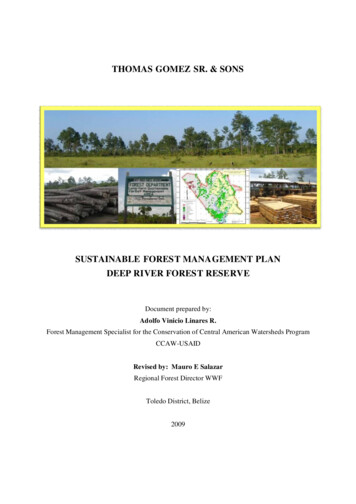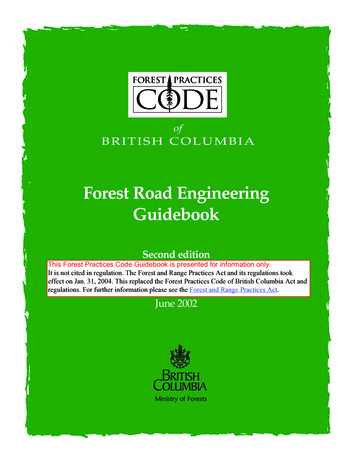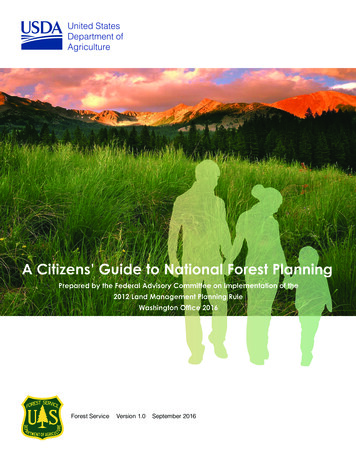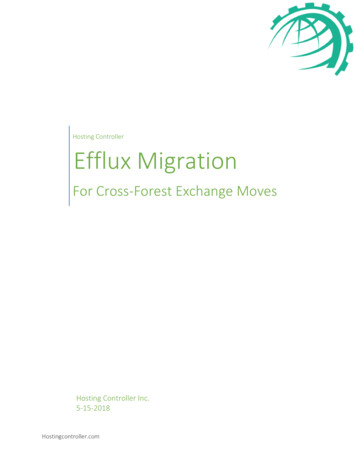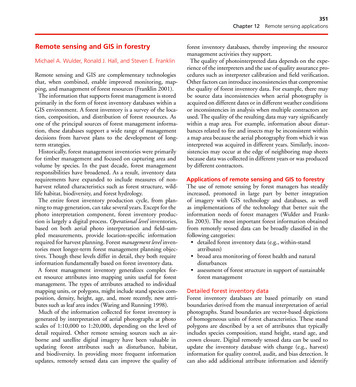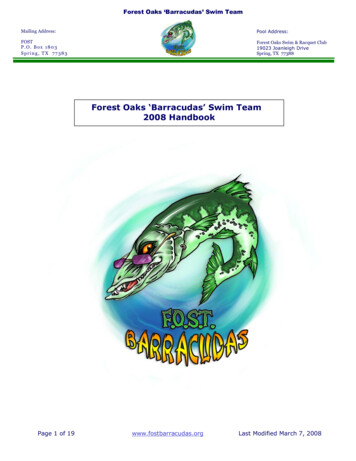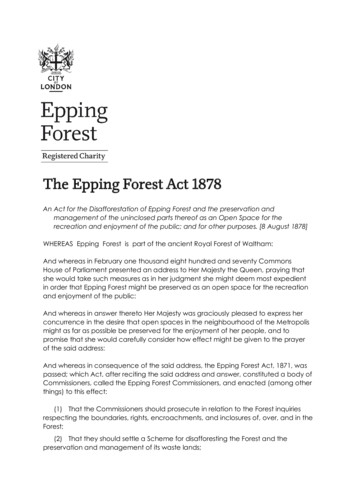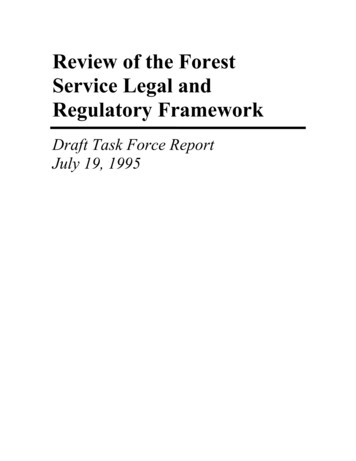
Transcription
Review of the ForestService Legal andRegulatory FrameworkDraft Task Force ReportJuly 19, 1995
Appendix ATable of ContentsExecutive SummaryA-3IntroductionStudy ObjectivesStudy MethodsA-5A-5A-5Section 1BackgroundA-7Section 2Changing MandatesA-9Section 3Long-Range PlanningA-11Section 4Public InvolvementDivergence of Public OpinionA-13Administrative and Judicial ReviewInfluence of Federal Advisory Committee ActA-14A-14Section 5Judicial ReviewA-16Section 6Procedural RequirementsProcess DuplicationRecycling Decisions Due to New InformationA-17A-17A-19ConclusionA-20A-13A-2Thomas Report
Appendix AExecutive SummarySecretary of Agriculture Dan Glickman directed Under Secretary Jim Lyons to form ajoint task force, consisting of Forest Service personnel and members of USDA’s Officeof the General Counsel, to review the key laws and regulations that guide themanagement of National Forest System lands. The focus of the study was an evaluationof how the laws and regulations relate to one another, and the impacts of thoserelationships on the management of the National Forests and Grasslands.The Task Force employed varied methods to evaluate the legislative and regulatoryinfluences over National Forest and Grassland management, and their respective effects.In order to achieve as comprehensive a perspective as possible, the team reviewed therelevant laws and regulations, held discussions with policy officials and Forest Servicefield personnel, and conducted research into the legal mandates of the Forest Service.The Task Force did not find strong oppositional conflict between statutory mandates.Rather, it found that over time there had been a trend toward a significant amount ofregulation of Forest Service activities by other federal agencies and a shift from historicmanagement priorities emphasizing commodity production toward pollution preventionand species preservation resulting from interpretation of law by the courts, and decreasedagency management discretion previously allowed in law. Protection of clean air andwater and species preservation must be assured for the Forest Service to implementprograms for commodity production and use of other renewable resources. This hasresulted in increased protection of the environment, while historic levels of commodityoriented activity, such as timber sales, have seen reductions.The Task Force identified some negative effects caused by the legal and regulatoryframework. Though largely unintentional, these effects relate to the effectiveness of theForest Service as a land managing agency. These are: The substantive requirements of the Endangered Species Act, the Clean Water Act,and the Clean Air Act, along with economic, social, legal, budgetary, andenvironmental uncertainties, greatly diminish the predictability of outputs. The availability and use of administrative and judicial review reduce the incentivesfor the public to engage in pre-decisional dialogue with the Forest Service. The constraints of the Federal Advisory Committee Act impede the Forest Service’seffective consideration of certain professional expertise and consensual grouprecommendations when making forest plan or project level decisions.Thomas ReportA-3
Appendix A The vague or undefined parameters of judicial review in many statutes result ingreater levels of uncertainty in Forest Service decision-making. The procedural requirements of laws and regulations, particularly the National ForestManagement Act, the National Environmental Policy Act, the Endangered SpeciesAct, the Clean Water Act, and the Clean Air Act lead to process duplication, creatingmanagement inefficiencies. Responding to new information and the interactions among the proceduralrequirements of the National Environmental Policy Act, the National ForestManagement Act, and the Endangered Species Act have led to inefficient cycles offorest plan and project level consultation and documentation.A-4Thomas Report
Appendix AIntroductionStudy ObjectivesShortly after taking office, Secretary of Agriculture Dan Glickman announced thebeginning of a review of the laws and regulations that guide the management of NationalForest System lands.1 James R. Lyons, Under Secretary of Agriculture for NaturalResources and Environment, described the project as “an opportunity to take a broaderview of what we need to do to function more effectively and efficiently in the ForestService.”2 This review has been conducted by a joint Task Force consisting of ForestService personnel and members of USDA’s Office of the General Counsel.The focus of the review was an evaluation of how certain key laws - the National ForestManagement Act (NFMA), the Endangered Species Act (ESA), the NationalEnvironmental Policy Act (NEPA), the Multiple-Use Sustained-Yield Act (MUSYA), theClean Water Act (CWA), the Clean Air Act (CAA), and the Federal Advisory CommitteeAct (FACA) - relate to one another, and the impacts of those relationships on themanagement of the National Forests and Grasslands. In addition, the Task Force wouldconsider the effects of regulations that implement the requirements of NFMA, ESA, andNEPA.Study MethodsThe Task Force utilized varied methods to evaluate the legislative and regulatoryinfluences over National Forest and Grassland management, and their respective effects.In order to achieve as comprehensive a perspective as possible, the team employed thefollowing methods: Review of the language of and legislative history behind laws affecting ForestService activities, specifically NFMA, ESA, NEPA, MUSYA, CWA, CAA, andFACA. Review of the language of regulations promulgated under the NFMA, ESA, andNEPA. Discussions with policy officials concerning the effects of, and relationships between,these laws and regulations.1Secretary’s Memorandum to James R. Lyons, Under Secretary for Natural Resources and Environment,April 12, 1995.2USDA press release No. 0312.95, April 12, 1995.Thomas ReportA-5
Appendix A Discussions with Forest Service field personnel concerning the practical effects ofthese laws and regulations on activities and planning. Historical research into the traditional mandates of the Forest Service, and thechanging roles of Congress and the Federal judiciary.This report contains the following information: Section 1 describes changes in the rolesof the Congress and the Federal judiciary in relation to National Forest System lands;Section 2 discusses the shift in management priorities for the Forest Service; Section 3discusses long-range planning of outputs on the National Forests and Grasslands; Section4 discusses the effectiveness of public involvement in Forest Service decision-making;Section 5 discusses standards for judicial review; and Section 6 discusses the efficiencyof certain procedural requirements.The Task Force found some unintended negative effects within the framework of lawsand regulations. These effects related to the viability of long-range planning, theeffectiveness of public and interagency involvement, the specification of judicial reviewstandards, and the efficiency of certain procedural requirements. The Task Force did notfind strong oppositional conflict between statutory mandates. Rather, it found thatovertime there had been a trend toward a significant amount of regulation of ForestService activities by other federal agencies and a shift from historic managementpriorities emphasizing commodity production toward pollution prevention and speciespreservation resulting from interpretation of law by the courts, and decreased agencymanagement discretion previously allowed in law. Protection of clean air and water andspecies preservation must be assured for the Forest Service to implement programs forcommodity production and use of other renewable resources. This has resulted inincreased protection of the environment, while historic levels of commodity-orientedactivity, such as timber sales, have seen reductions.A-6Thomas Report
Appendix ASection 1BackgroundThe mission of the Forest Service historically has been to capture a wide variety ofbenefits from National Forest System lands, striving to provide “the greatest good for thegreatest number in the long run”.3 The agency’s Organic Administration Act establishesthat the purposes of the National Forests are to “improve and protect the forest.securingfavorable conditions of water flows, and to furnish a continuous supply of timber for theuse and necessities of citizens of the United States.”4 This charter was broadened inMUSYA, which directs the Secretary of Agriculture to administer the national forests for“outdoor recreation, range, timber, watershed, and wildlife and fish purposes” and toconsider the “relative values of the various resources in particular areas.”5 These laws, asinterpreted by the courts, provided the Forest Service with wide discretion to consider thewhole range of National Forest and Grassland benefits and to select the course that “bestmeets the needs of the American people.”From the origin of the National Forests and Grasslands until after World War II, the legalframework for National Forest System management was characterized by Congressionaldelegation of broad management authority to the Secretary to Agriculture. Consistentwith its Constitutional authority, Congress provided the principal oversight, albeitsomewhat passively. The role of the Federal judiciary was limited to a handful of casesreviewing, and generally affirming, the Secretary’s exercise of his Congressionallydelegated authority. Other Federal agencies had very limited roles in affecting theadministration of National Forest System lands.However, after World War II, Congress embarked on a period of gradually increasinglegislative activity affecting National Forest System management.6 Reflecting anincreasing public interest in the recreational, aesthetic, and other non-commodity valuesof the National Forests and Grasslands, and environmental quality in general, Congressimposed numerous substantive and procedural constraints on the previously broad ForestService management authority, culminating with the passage of several major pieces oflegislation in the 1970’s. The rigorous procedural requirements of many of these statutesgenerally reflected a growing public interest in the management of natural resources onfederal lands for non-commodity purposes.3Letter from the Secretary of Agriculture to Gifford Pinchot, February 1905.16 U.S.C. 473-475, 477-482, 551, Act of June 4, 1897.516 U.S.C. 528-531, Act of June 12, 1960. Provided for elsewhere is the use of the National Forests forenergy and mineral resource production.6The Administrative Procedures Act , passed at the end of World War II, exempted public lands from thenotice requirements of its rule-making requirements. Secretary of Agriculture Harden waived thisexemption in 1971.4Thomas ReportA-7
Appendix AIn addition, there has been the substantial growth in administrative appeals of ForestService decisions. Furthermore, the role of the Federal courts in the management ofNational Forest System lands began to change dramatically in the early 1970’s.Encouraged by Supreme Court decisions on the Constitutional law of standing andcitizen suit provisions in federal legislation, litigation challenging the decisions of theForest Service increased substantially. Inspired by success in at least some Federalcourts and by provisions for attorney fee awards, plaintiffs have continued to file dozensof lawsuits against the Forest Service each year under such statutes as NEPA, ESA, andCWA. Today, plaintiffs seek judicial review of decisions for compliance with theaccumulated requirements of the multiple statutes enacted over the previous decades.A-8Thomas Report
Appendix ASection 2Changing MandatesThe Principal Laws Relating to Forest Service Activities7 lists 198 laws that governagency activities, beginning with the U.S. Mining Laws in 1872, and continuing throughthe Tourism Policy and Export Promotion Act of 1992. Over 60 percent of these lawswere enacted or significantly amended in the last three decades, including six of theseven laws which served as the focus of this study. Appendix A describes someimportant features of these statutes.The cumulative effect of these laws has been to limit the management discretion on theNational Forests and Grasslands set forth in the Organic Act and MUSYA. Today, thefirst priority of National Forest System management, as defined in law and interpreted bythe courts, has become pollution prevention and species preservation. In response, JackWard Thomas has stated that “it appears to me, at least, that we have a de facto policy ofbiodiversity protection, particularly for National Forest lands. It becomes an overridingobjective.”8 In a similar response, the Forest Service has declared that its “first priority isensuring ecosystem health in order to provide the foundation for all life.”9The groundwork for this adjustment was established by language in ESA that “all federaldepartments and agencies shall seek to conserve endangered and threatened species andshall use their authorities in furtherance of the purposes of this Act.”10 and wasconfirmed by a Supreme Court ruling in 1978 that Congress had made “a consciousdecision . . . to give endangered species priority over the ‘primary missions’ of federalagencies,”11 This adjustment was furthered by language in NFMA that directs the agencyto “provide for diversity of plant and animal communities . . . in order to meet overallmultiple-use objectives,”12 and also by USDA’s regulations implementing NFMA whichrequire that “fish and wildlife habitat shall be managed to maintain viable populations ofexisting native and desired non-native vertebrate species in the planning area.”13In addition, the national requirements of the CAA and the CWA clearly give priority tothe prevention of air and water pollution. Under these laws, federal land managers havea responsibility to protect air quality-related values, such as visibility, and water quality.The states establish their own air and water quality standards equal to or more stringent7USDA Forest Service, 1993.Thomas, J.W. 1993 In The forest conference. Transcript, 207-211. Portland, OR: Johnson, Beovich,Kirk, May, and Friend, Inc.9USDA Forest Service, 1994, The Forest Service Ethics and Course to the Future, FS 567, 2.1016 U.S.C. 1531(c)(1).11Tennessee Valley Authority v. Hill, 437 U.S. 153 185 (1978).1216 U.S.C. 1604(g)(3)(b).1336 CFR 219.19.8Thomas ReportA-9
Appendix Athan the federal standards set by the Environmental Protection Agency. The ForestService must meet all applicable requirements of these plans, including acquiringpermits, before its work can proceed.Only after protection of clean air and water and species preservation has been assured isit possible for the Forest Service to implement programs of use for other renewableresources, rather than utilize the management discretion provided in earlier legislation topursue multiple-use goals.14 This has resulted in increased protection of the environment,while historic levels of commodity-oriented activity, such as timber sales, have seenreductions.14One of the basic concepts of multiple use is that all of the named resources in general are of equalpriority, but the relative values of the various resources on particular or localized areas, and viewed in thebroadest public sense, will be considered in the administrative application of management plans.”U.S.C.C.A.N. 86th Cong. Sess. v.2. Legislative History of H.R. 1551, April 25, 1960, 2380-2383 (Letterfrom Acting Secretary Peterson to Speaker Johnson, Feb. 5, 1960).A-10Thomas Report
Appendix ASection 3Long-Range PlanningIn 1960 Congress enacted MUSYA, declaring that the National Forest System lands areto be managed for a high-level annual or regular period output of the various multipleuses (recreation, range, timber, watershed and wildlife and fish).15 By 1970 the PublicLand Law Review Commission recognized the need for adjusting and streamlining lawsregarding the National Forests and Grasslands as well as other federal lands. Due topublic interest in environmental protection, Congress enacted laws to enhance thenation’s environmental quality. It did so, however, without coordinating and integratingthese new legal authorities (e.g. CAA, CWA, and ESA).NFMA, also passed during this period, began a new era in forest planning. NFMA-styleplanning represents the most detailed and participatory forest and rangeland planningprocess ever undertaken.16 NFMA granted the Forest Service a charter to make land-usedecisions under the efficient framework of a staged decision-making system (regionalguides, forest plans and project level decisions).Forest plans are powerful and useful tools. The planning process has allowed ForestService land managers to identify the renewable resource potential of the NationalForests and Grasslands while publicly establishing a protective strategy to sustain theseresources. But forest plans are not “silver bullets” that resolve difficult issues orguarantee ecological conditions.The NFMA planning model was premised on a concept that all resources should bequantitatively accounted for and an optimal solution identified and selected. This systemis attractive because it implies a rational, scientifically credible decision-making systemthat yields certainty. However, forest planning is constrained by the ecological andeconomic information available and the ability to make accurate predictions from thatdata. Furthermore, that information is changing and being cycled through the planningprocess. For example, planning for species diversity, especially endangered or threatenedspecies is ongoing, because the ESA requires the re-evaluation of on-going projectswhenever new listings are made, critical habitat is designated, or other new informationcomes to light.1516 U.S.C. 531.The evolution of planning for uses of the National Forest System was summarized in the EnvironmentalImpact Statement for the NFMA Planning Regulation, 36 CFR 219, 44 Fed. Reg. 53934-35 (1979).Wilkinson and Anderson also have an excellent recount of the evolution of land use planning in the ForestService in “Land and Resource Planning in the National Forests”, 64 Oregon L. Rev., No. 1 & 2, pp. 19-36(1985). The Public Land Law Review Commission Report, One Third of the Nation’s Land, pp. 41-65(1970), also has a discussion of planning for the National Forests and Grasslands and other landmanagement planning.16Thomas ReportA-11
Appendix AKey components of forest plans, especially the timber allowable sale quantity, timbersuitable acres, grazing animal unit months, grazing suitable acres, mineral access, andother projections, were expected to change infrequently. Instead, on some NationalForests and Grasslands these projections are often changing as a result of the operation ofvarious laws, like the CWA and ESA, as well as from substantive direction from annualappropriations acts. National Forest System users (recreationists, water developers,miners, hunters and fishermen, loggers, and others) assert that there is no stability of useand access, as they thought forest plans would provide.The Forest Service has issued a proposed rule to revise the NFMA planning regulation.17One of the goals of the proposed regulation is to streamline the forest planningprocedures and forest plans. However, it may no longer be reasonable to assume that anyplanning process, no matter how efficient, can assure a particular outcome, particularly inan open system subject to changing conditions. The combination of changing publicexpectations, new information, legal interactions, and ecological disturbance, such asfire, windstorm, or flooding, can upset the most carefully crafted forest plan. The ForestService is seeking to move toward an adaptive planning system that continues publicinvolvement and empowers land managers to accomplish professional, scientificallybased land and resource management in an efficient and affordable manner. But theinherent limitations of long-range land use planning inhibit the flexibility that is neededto manage dynamic natural systems.17National Forest System Land and Resource Management Planning, Proposed Rule, 60 Fed. Reg. 18886(1995).A-12Thomas Report
Appendix ASection 4Public InvolvementPublic involvement is a keystone of NFMA and NEPA. The Forest Service makessubstantial efforts to learn the underlying values and opinions of the public as a part of itsdecision-making process. Building and maintaining dialogues with the public, otherfederal agencies, and with State, local and tribal government is essential to the operationof the Forest Service.The public’s access to post-decisional administrative and judicial review is a positivecomponent of our political system. However, this form of oversight is not intended toovershadow or replace pre-decisional public involvement.Early involvement by the public gives the agency the opportunity to identify and, whenpossible, reduce or eliminate conflicts by considering public values and opinions whenmaking decisions. The effectiveness of this approach is constrained, however, by thewide divergence of public opinion on resource issues, incentives for the public to utilizeadministrative and judicial review to alter decisions, and by limitations imposed byfederal law (e.g., FACA).Divergence of Public OpinionPublic interest in the National Forests and Grasslands has never been higher. Effortscontinue in the Forest Service to be more inclusive, proactive, and open in discussionswith citizens who are interested in National Forest System management. The ForestService’s decision-making process (regional guides, forest plans, and project leveldecisions) is subject to repeated public involvement requirements and administrativeappeal opportunities.However, an involved and informed citizenry does not guarantee consensus regardingmanagement of public natural resources. Many opposing viewpoints are advocated bywell-funded and sophisticated special interest groups, as well as by individuals.Furthermore, many forums exist for proponents of various viewpoints to advance theircause, leading to an atmosphere where it is difficult to reach a final decision, andagreement on issues is elusive.Thomas ReportA-13
Appendix AAdministrative and Judicial ReviewDespite having multiple opportunities for involvement, many citizens and groups haveturned away from pre-decisional engagement with the Forest Service, preferring insteadto settle their disputes through administrative and judicial appeal. Some groups orindividuals raise issues only to establish a record of having done so, without seriouslytrying to build consensus or resolve disputes. They know that they can easily file anadministrative appeal, and later sue in federal court, if the decision does not go their way,with the government often paying their legal costs regardless of who wins.For example, despite extensive public involvement in preparing its forest plan, theFlathead National Forest received numerous appeals when its Plan decision wasannounced in 1986. Two environmental groups expressed an intent to file lawsuits, eventhough the appeal decisions directed the Forest Service to conduct additional analysis inresponse to some of their concerns. The Forest employed a mediator to facilitatenegotiations, but talks broke down before substantive discussions had even begun, andthe environmental groups proceeded with their lawsuits. The U.S. District Court ruled infavor of the Forest Service on all thirteen claims. The plaintiffs appealed, and theappellate court upheld the lower court on twelve claims and reversed on one claim.Thus, after six years of administrative appeals and litigation, the Plan was finallyapproved, with Forest Service paying costs for the one reversed claim in the amount of 180,000.The availability of broad injunctive relief and fee-shifting mechanisms has served topromote litigious behavior by those who disagree with a decision of a Forest Service lineofficer. The Forest Service currently finds itself in a working environment that ischaracterized by polarization and by a proliferation of litigation. Between 1989 and 1994the Forest Service successfully defended 39 of 48 cases involving forest plans and 62 of80 NEPA cases. While the proportion of successfully defended cases is a testament toForest Service efforts to “obey the law,” each case also represents a tremendous publicand private investment. Special interest groups, citizens and Forest Service decisionmakers share a concern that litigation is unduly costly in time, money and humanresources.Influence of the Federal Advisory Committee ActFACA was designed as an “open government” law to regulate committees that provideadvice to the federal government. Unfortunately, the language of FACA is so broad thatit may throw into question the federal government’s ability to receive advice frommembers of the public who are not members of a chartered advisory committee. TheForest Service has a legal and regulatory mandate to consult the public on NationalForest System management issues. Both NFMA and NEPA have strong publicinvolvement requirements.FACA constrains the Forest Service in consulting with the public in at least one area.A-14Thomas Report
Appendix AIn cases where the Forest Service does not have the professional expertise or thenecessary information, but knows that the expertise or information exists, it can bedifficult to get the information and recommendations. Advice must be sought in the samemanner as used with any other member of the public and used in the same way in thedecision-making process. This is not to say the expert view should not be adjusted inlight of public policy making, just that the same procedural rules must be adhered to bythose seeking expert advice and those seeking general comments.In addition, concerns have been expresssed that public meetings designed only to helpunderstand the values and opinions of the community concerning management of aNational Forest or Grassland could result in violation of the law if those in attendancedecide to provide the Forest Service with their unsolicited recommendations. In order forthis to be treated as violation of the law, the recommendations must reflect the consensusof the group.In order to seek consensual advice, the Forest Service is required to charter an advisorycommittee, following a time consuming process controlled by other federal agencies(General Services Administration and Office of Management and Budget). At present,the Department of Agriculture is operating under an advisory committee ceiling.18 Thus,FACA continues to force the Forest Service to curtail some of its public involvementactivities out of caution of violating its provisions.19FACA prohibits federal agencies from obtaining advice or recommendations fromadvisory committees with non-federal members unless certain requirements are met.FACA was recently modified by Section 204 of the Unfunded Mandates Reform Act of1995, which exempted advisory committees consisting solely of State, local and tribalelected officials or their designees with authority to act on their behalf, and where suchmeetings are solely concerned with management of federal programs that shareintergovernmental responsibilities or administration.1819Letter from OMB Director Alice Rivlin to Secretary of Agriculture Dan Glickman, April 19, 1995.See Northwest Forest Resource Council v. Espy, 846 F. Supp. 1009 (D.D.C. 1994).Thomas ReportA-15
Appendix ASection 5Judicial ReviewIt is well accepted that Congress does not intend every federal decision to be subject tojudicial review. But unless Congress has spoken with specificity, the courts are forced todetermine what is judicially reviewable through a trial and error cycle of litigation.Congress did not include a provision in NFMA to guide the courts in determining whichForest Service decisions should be subjected to judicial review. Without specificguidance, the courts have had to start from scratch to develop a set of precedential rulingsthat apply all other laws in combination with the NFMA. The ad hoc nature of thisapproach is illustrated by the current conflict between U.S. Circuit Courts of Appealregarding whether forest plans by themselves are even subject to judicial review.20In the late 1980’s and early 1990’s legislation was introduced to establish a judicialreview provision for forest plans and project level decisions. Although never enacted,these proposals addressed several key issues, including: (1) who can bring lawsuits; (2)what aspects of forest management are intended to be subject to judicial oversight; (3)where is the appropriate location to file a lawsuit; (4) when is the appropriate time toinitiate a lawsuit; (5) which judicial standards of review should be applied; and (6) therelief available.As legal interpretations evolve, the Forest Service is forced to re-examine past decisionsas well as adjust the course of new actions. Congress recognized the social, economicand biological importance of a smooth transition in management direction when itprovided that National Forests and Grasslands would be permitted to continuemanagement under existing plans until new NFMA plans were developed.21 Someplaintiffs disagree, and continue to seek injunctions on provisions of existing forest planswhile the plans are being modified.The uncertainty this creates for the Forest Service is illustrated by Judge Dwyer’s recentdecision22 upholding the Northern Spotted Owl Record of Decision (ROD). JudgeDwyer identified several circumstances that may cause a need to reconsider the ROD.20Compare Resources Ltd. v. Robertson, 35 F. 3d 1300 (9th Cir., 1993) and Sierra Club v. Robertson, 28F. 3d. 753 (8th Cir. 1994). The lack of a judicial review standard is also a significant problem underNEPA.2116 U.S.C. 1604(c).22Seattle Audubon Society v. L
Service."2 This review has been conducted by a joint Task Force consisting of Forest Service personnel and members of USDA's Office of the General Counsel. The focus of the review was an evaluation of how certain key laws - the National Forest Management Act (NFMA), the Endangered Species Act (ESA), the National



